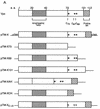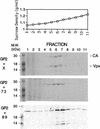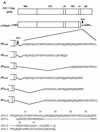Human immunodeficiency virus type 2 Vpx-Gag interaction
- PMID: 9573303
- PMCID: PMC110118
- DOI: 10.1128/JVI.72.6.5271-5275.1998
Human immunodeficiency virus type 2 Vpx-Gag interaction
Abstract
Incorporation of Vpx into human immunodeficiency virus type 2 (HIV-2) virus-like particles is mediated by the Gag polyprotein. We have identified residues 15 to 40 of Gag p6 and residues 73 to 89 of Vpx as being necessary for virion incorporation. In addition, we show enhanced in vitro binding of Vpx to a chimeric HIV-1/HIV-2 Gag construct containing residues 2 to 49 of HIV-2 p6 and demonstrate that the presence of residues 73 to 89 of Vpx allows for in vitro binding to HIV-2 Gag.
Figures









Similar articles
-
Intracellular transport and virion incorporation of vpx requires interaction with other virus type-specific components.Virology. 1993 Mar;193(1):222-33. doi: 10.1006/viro.1993.1118. Virology. 1993. PMID: 8438567
-
Localization of the Vpx packaging signal within the C terminus of the human immunodeficiency virus type 2 Gag precursor protein.J Virol. 1994 Oct;68(10):6161-9. doi: 10.1128/JVI.68.10.6161-6169.1994. J Virol. 1994. PMID: 8083957 Free PMC article.
-
Vpx proteins of SIVmac239 and HIV-2ROD interact with the cytoskeletal protein alpha-actinin 1.J Gen Virol. 2004 Nov;85(Pt 11):3291-3303. doi: 10.1099/vir.0.80198-0. J Gen Virol. 2004. PMID: 15483243
-
Identification of the nuclear localization signal of human immunodeficiency virus type 2 Vpx.Virology. 2003 Jun 20;311(1):7-15. doi: 10.1016/s0042-6822(03)00093-x. Virology. 2003. PMID: 12832198
-
[Study of molecular function of proteins in human immunodeficiency virus].Yakugaku Zasshi. 2013;133(10):1103-11. doi: 10.1248/yakushi.13-00200. Yakugaku Zasshi. 2013. PMID: 24088354 Review. Japanese.
Cited by
-
Functional analysis of the simian immunodeficiency virus Vpx protein: identification of packaging determinants and a novel nuclear targeting domain.J Virol. 2001 Jan;75(1):362-74. doi: 10.1128/JVI.75.1.362-374.2001. J Virol. 2001. PMID: 11119605 Free PMC article.
-
Vif is largely absent from human immunodeficiency virus type 1 mature virions and associates mainly with viral particles containing unprocessed gag.J Virol. 2001 Jun;75(12):5504-17. doi: 10.1128/JVI.75.12.5504-5517.2001. J Virol. 2001. PMID: 11356958 Free PMC article.
-
Vpx rescues HIV-1 transduction of dendritic cells from the antiviral state established by type 1 interferon.Retrovirology. 2011 Jun 22;8:49. doi: 10.1186/1742-4690-8-49. Retrovirology. 2011. PMID: 21696578 Free PMC article.
-
A conserved dileucine-containing motif in p6(gag) governs the particle association of Vpx and Vpr of simian immunodeficiency viruses SIV(mac) and SIV(agm).J Virol. 1999 Dec;73(12):9992-9. doi: 10.1128/JVI.73.12.9992-9999.1999. J Virol. 1999. PMID: 10559313 Free PMC article.
-
In vivo infection dynamics and human adaptive changes of SIVsm-derived viral siblings SIVmac239, SIVB670 and SIVhu in humanized mice as a paralog of HIV-2 genesis.Front Virol. 2021;1:813606. doi: 10.3389/fviro.2021.813606. Epub 2021 Dec 31. Front Virol. 2021. PMID: 37168442 Free PMC article.
References
-
- Chakrabarti L, Guyader M, Alizon M, Daniel D, Desrosiers R C, Tiollais P, Sonigo P. Sequence of simian immunodeficiency virus from macaque and its relationship to other human and simian retroviruses. Nature. 1987;328:543–547. - PubMed
-
- Franchini G, Rusche J R, O’Keeffe T J, Wong-Staal F. The human immunodeficiency virus type 2 (HIV-2) contains a novel gene encoding a 16 kD protein associated with mature virions. AIDS Res Hum Retroviruses. 1988;4:243–250. - PubMed
Publication types
MeSH terms
Substances
Grants and funding
LinkOut - more resources
Full Text Sources
Other Literature Sources
Research Materials

